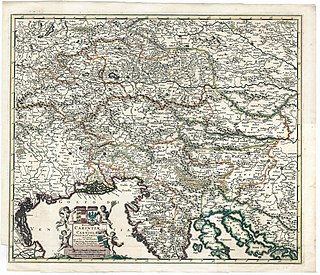
The history of Slovenia chronicles the period of the Slovenian territory from the 5th century BC to the present. In the Early Bronze Age, Proto-Illyrian tribes settled an area stretching from present-day Albania to the city of Trieste. The Slovenian territory was part of the Roman Empire, and it was devastated by the Migration Period's incursions during late Antiquity and the Early Middle Ages. The main route from the Pannonian plain to Italy ran through present-day Slovenia. Alpine Slavs, ancestors of modern-day Slovenians, settled the area in the late 6th Century AD. The Holy Roman Empire controlled the land for nearly 1,000 years, and between the mid-14th century and 1918 most of Slovenia was under Habsburg rule. In 1918, Slovenes formed Yugoslavia along with Serbs and Croats, while a minority came under Italy. The state of Slovenia was created in 1945 as part of federal Yugoslavia. Slovenia gained its independence from Yugoslavia in June 1991, and is today a member of the European Union and NATO.

Yugoslavia was a country in Southeast and Central Europe for most of the 20th century. It came into existence in 1918 following World War I, under the name of the Kingdom of Serbs, Croats and Slovenes from the merger of Kingdom of Serbia with the provisional State of Slovenes, Croats and Serbs, and constituted the first union of the South Slavic people as a sovereign state, following centuries in which the region had been part of the Ottoman Empire and Austria-Hungary. Peter I of Serbia was its first sovereign. The kingdom gained international recognition on 13 July 1922 at the Conference of Ambassadors in Paris. The official name of the state was changed to Kingdom of Yugoslavia on 3 October 1929.

The Yugoslav People's Army, also called the Yugoslav National Army, was the military of the Socialist Federal Republic of Yugoslavia and its antecedents from 1945 to 1992.
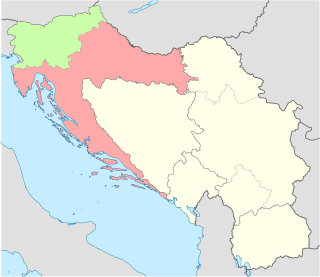
The Brioni Agreement, also known as the Brioni Declaration, is a document signed by representatives of Slovenia, Croatia, and Yugoslavia under the political sponsorship of the European Community (EC) on the Brijuni Islands on 7 July 1991. The agreement sought to create an environment in which further negotiations on the future of Yugoslavia could take place. However, ultimately it isolated the federal prime minister Ante Marković in his efforts to preserve Yugoslavia, and effectively stopped any form of federal influence over Slovenia. This meant the Yugoslav People's Army (JNA) would focus on combat in Croatia, creating a precedent of redrawing international borders and staking the EC's interest in resolving the Yugoslav crisis.

The Social Democrats is a centre-left and pro-European social-democratic political party in Slovenia led by Tanja Fajon. From 1993 until 2005, the party was known as the United List of Social Democrats. It is the successor of the League of Communists of Slovenia. As of 2022, the party is a member of a three-party coalition government with Robert Golob's Freedom Movement alongside The Left, as well as a full member of the Party of European Socialists and Progressive Alliance.
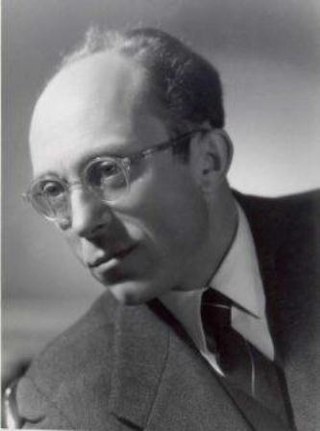
Boris Pahor, OMRI was a Slovene novelist from Trieste, Italy, who was best known for his heartfelt descriptions of life as a member of the Slovenian minority in pre–Second World War increasingly fascist Italy as well as a Nazi concentration camp survivor. In his novel Necropolis he visits the Natzweiler-Struthof camp twenty years after his relocation to Dachau. Following Dachau, he was relocated three more times: to Mittelbau-Dora, to Harzungen, and finally to Bergen-Belsen, which was liberated on 15 April 1945.
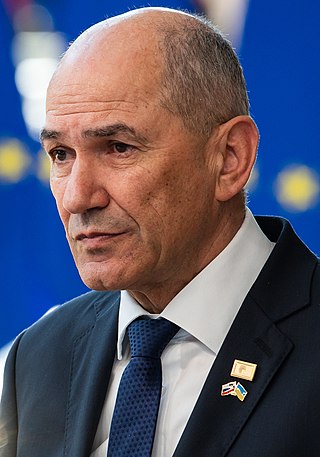
Ivan Janša, baptized and best known as Janez Janša, is a Slovenian politician who served three times as a prime minister of Slovenia, a position he had held from 2004 to 2008, from 2012 to 2013, and from 2020 to 2022. Since 1993, Janša has led the Slovenian Democratic Party, which has emerged as the pre-eminent Slovenian conservative party. Janša lost his fourth bid for prime minister in April 2022, his party defeated by the Freedom Movement party.
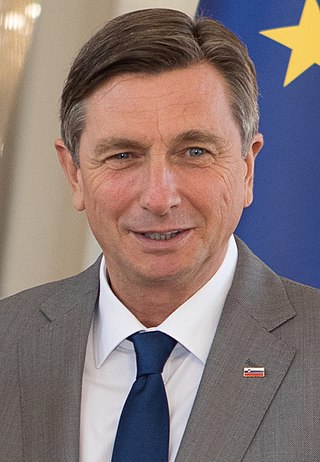
Borut Pahor is a Slovenian politician who served as President of Slovenia from 2012 to 2022. He previously served as Prime Minister of Slovenia from November 2008 to February 2012.

The Battle of Vukovar was an 87-day siege of Vukovar in eastern Croatia by the Yugoslav People's Army (JNA), supported by various paramilitary forces from Serbia, between August and November 1991. Before the Croatian War of Independence the Baroque town was a prosperous, mixed community of Croats, Serbs and other ethnic groups. As Yugoslavia began to break up, Serbia's President Slobodan Milošević and Croatia's President Franjo Tuđman began pursuing nationalist politics. In 1990, an armed insurrection was started by Croatian Serb militias, supported by the Serbian government and paramilitary groups, who seized control of Serb-populated areas of Croatia. The JNA began to intervene in favour of the rebellion, and conflict broke out in the eastern Croatian region of Slavonia in May 1991. In August, the JNA launched a full-scale attack against Croatian-held territory in eastern Slavonia, including Vukovar.

The Ten-Day War, or the Slovenian War of Independence, was a brief armed conflict that followed Slovenia's declaration of independence from Yugoslavia on 25 June 1991. It was fought between the separatists of the Slovenian Territorial Defence and the Yugoslav People's Army. It lasted from 27 June 1991 until 7 July 1991, when the Brioni Accords were signed.

The Croatian War of Independence was fought from 1991 to 1995 between Croat forces loyal to the Government of Croatia—which had declared independence from the Socialist Federal Republic of Yugoslavia (SFRY)—and the Serb-controlled Yugoslav People's Army (JNA) and local Serb forces, with the JNA ending its combat operations in Croatia by 1992. In Croatia, the war is primarily referred to as the "Homeland War" and also as the "Greater-Serbian Aggression". In Serbian sources, "War in Croatia" and (rarely) "War in Krajina" are used.

Ilirska Bistrica is a town in the Inner Carniola region of southwestern Slovenia. It is the administrative seat of the Municipality of Ilirska Bistrica.
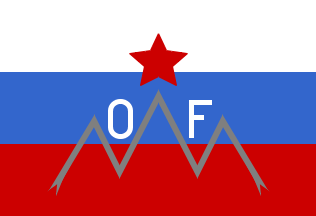
The Liberation Front of the Slovene Nation, or simply Liberation Front, originally called the Anti-Imperialist Front, was a Slovene anti-fascist political party. The Anti-Imperialist Front had ideological ties to the Soviet Union in its fight against the imperialistic tendencies of the United States and the United Kingdom, and it was led by the Communist Party of Slovenia. In May 1941, weeks into the German occupation of Yugoslavia, in the first wartime issue of the illegal newspaper Slovenski poročevalec, members of the organization criticized the German regime and described Germans as imperialists. They started raising money for a liberation fund via the second issue of the newspaper published on 8 June 1941. When Germany attacked the Soviet Union, the Anti-Imperialist Front was formally renamed and became the main anti-fascist Slovene civil resistance and political organization under the guidance and control of the Slovene communists. It was active in the Slovene Lands during World War II. Its military arm was the Slovene Partisans. The organisation was established in the Province of Ljubljana on 26 April 1941 in the house of the literary critic Josip Vidmar. Its leaders were Boris Kidrič and Edvard Kardelj.
Statehood Day is a holiday that occurs on every 25 June in Slovenia to commemorate the country's declaration of independence from Yugoslavia in 1991. Although the formal declaration of independence did not come until 26 June 1991, Statehood Day is considered to be 25 June since that was the date on which the initial acts regarding independence were passed and Slovenia became independent. Slovenia's declaration jumpstarted the Ten-Day War with Yugoslavia, which it eventually won.
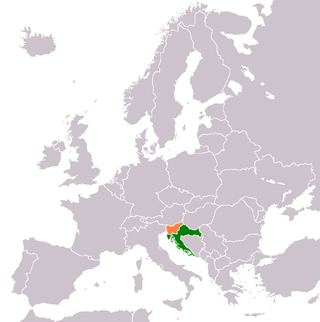
Following the breakup of Yugoslavia in 1991, Slovenia and Croatia became independent countries. As the border between the countries had not been determined in detail prior to independence, several parts of the border were disputed, both on land and at the sea, namely in the Gulf of Piran.
26 October Barracks is a former barracks of the Slovenian Armed Forces, located at Stara Vrhnika in Vrhnika Municipality, central Slovenia. It falls under the 25th military-territorial Vrhnika Slovenian Armed Forces Command.
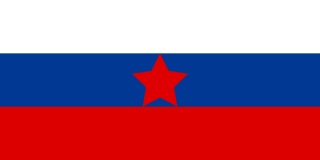
The Slovene Partisans, formally the National Liberation Army and Partisan Detachments of Slovenia, were part of Europe's most effective anti-Nazi resistance movement led by Yugoslav revolutionary communists during World War II, the Yugoslav Partisans. Since a quarter of Slovene ethnic territory and approximately 327,000 out of total population of 1.3 million Slovenes were subjected to forced Italianization since the end of the First World War, the objective of the movement was the establishment of the state of Slovenes that would include the majority of Slovenes within a socialist Yugoslav federation in the postwar period.

World War II in the Slovene Lands started in April 1941 and lasted until May 1945. The Slovene Lands were in a unique situation during World War II in Europe. In addition to being trisected, a fate that also befell Greece, Drava Banovina was the only region that experienced a further step — absorption and annexation into neighboring Nazi Germany, Fascist Italy, and Hungary. The Slovene-settled territory was divided largely between Nazi Germany and the Kingdom of Italy, with smaller territories occupied and annexed by Hungary and the Independent State of Croatia.
The Austro-Slovene conflict in Carinthia was a military engagement that ensued in the aftermath of World War I between forces loyal to the State of Slovenes, Croats and Serbs and later the Kingdom of Serbs, Croats and Slovenes, and forces loyal to the Republic of German-Austria. The main theater of the conflict was the linguistically mixed region in southeastern Carinthia. The conflict was settled by the Treaty of Saint-Germain in 1919, which stipulated that the territorial dispute be resolved by a plebiscite.
Milan Aksentijević is a retired Yugoslav army Major-General. Aksentijević was one of the few senior Yugoslav army officers to be involved in all three of the wars in Slovenia, Croatia, and Bosnia during the break-up of Yugoslavia.















